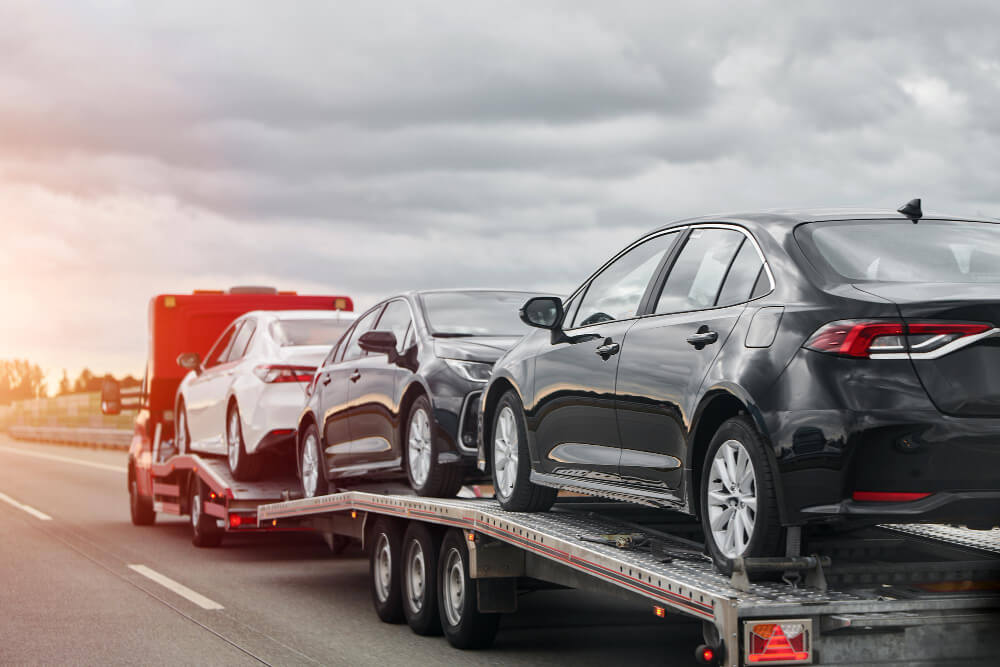Planning to transport your vehicle across state lines? At Agile Towing Company, we understand the importance of choosing the right transport method for your car.
Now that you’ve decided to have your car professionally transported rather than driving it yourself, the next important decision is choosing between enclosed and open transport. Ready to make an informed decision? We’d like to help you understand the key differences between these methods. For professional long-distance towing services you can reach our team at 1 (405) 449-8100.
Open Transport in Long-distance Car Towing
Open transport remains the most common method for vehicle shipping across the country. These carriers feature exposed trailers that typically accommodate 8-10 vehicles simultaneously. Think of the car carriers you’ve seen on highways – those are open transport trucks. The multi-level design allows for efficient transport while maintaining proper safety standards for each vehicle.
Benefits of Open Transport
Cost-effectiveness stands out as the primary advantage of open transport. Since these carriers can move multiple vehicles simultaneously, the operational costs spread across several customers. This efficiency translates to lower transport fees for each vehicle owner. The price difference can be significant, often 40-60% less than enclosed transport options.
The widespread availability of open carriers means flexible scheduling options. Most routes have frequent departures, making it easier to find a convenient shipping time that fits your schedule. This accessibility often results in faster pickup times compared to enclosed transport. Many transport companies can arrange pickup within 1-3 business days for open transport.
Professional drivers operating open carriers have extensive experience securing vehicles of all types. They use specialized equipment and proven techniques to ensure each car remains stable throughout the journey. Regular inspections during transport help maintain security and proper positioning.
Limitations of Open Transport
Your vehicle faces exposure to weather elements during transport. Rain, snow, sun, and road debris can all reach your car. While professional carriers maintain proper tie-downs and security measures, they can’t control environmental factors. This exposure might concern owners of vehicles with special finishes or delicate exterior components.
Road debris presents another consideration. While incidents are rare, small rocks or debris from the road could potentially contact your vehicle during transit. Professional drivers maintain safe distances and follow optimal routes to minimize these risks. They also position vehicles strategically on the carrier to reduce exposure to road elements.
Enclosed Transport: Premium Protection for Your Vehicle
Enclosed transport provides complete coverage for vehicles during shipping. These specialized carriers feature solid walls and roofs, creating a protective shell around your car. Two main types exist: hard-side carriers with rigid walls and soft-side carriers using heavy-duty curtain sides. Each type offers distinct advantages for different transport needs.
Advantages of Enclosed Transport
Complete protection from environmental elements marks the primary benefit. Your vehicle travels sheltered from rain, snow, sun, and road debris. This protection proves particularly valuable for high-end finishes, custom paint jobs, or classic cars. The enclosed environment also maintains more stable temperature conditions during transport.
Enhanced security comes standard with enclosed transport. Your vehicle remains out of sight during transit, reducing potential security risks. Most enclosed carriers also feature advanced tracking systems and specialized tie-down equipment. The enclosed space allows for more precise climate control and protection from dust and debris.
Many enclosed carriers feature hydraulic lift gates for safer loading and unloading. This equipment proves especially valuable for low-clearance vehicles or cars with modified suspensions. The enclosed space also allows for more specialized securing methods, particularly beneficial for unique or modified vehicles.
Understanding the Trade-offs
Higher costs accompany the additional protection of enclosed transport. Expect to pay 40-60% more compared to open transport. These carriers typically handle fewer vehicles per trip and require specialized equipment, resulting in higher operational costs. The premium price reflects both the enhanced protection and the specialized nature of the service.
Limited availability can affect scheduling flexibility. Fewer enclosed carriers operate compared to open transport, potentially leading to longer wait times for pickup. Advanced booking often becomes necessary, especially during peak seasons. Some routes might have limited enclosed transport options, requiring more flexible scheduling on your part.
Cost Factors: Making Sense of the Numbers
Transport costs vary based on several factors beyond just the carrier type. Distance naturally plays a major role – longer routes mean higher fees. Vehicle size and condition also affect pricing, as do seasonal demand fluctuations. Peak moving seasons, typically during summer months, often command premium rates.
Insurance coverage differs between options. While both methods require basic carrier insurance, enclosed transport often includes higher coverage limits. Consider your vehicle’s value and your comfort level with potential risks when evaluating costs. Additional insurance options might be available for particularly valuable vehicles.
Choosing Your Ideal Transport Method
Your choice between enclosed and open transport should reflect your specific needs. Consider these key factors:
When Open Transport Makes Sense
- Standard daily-driver vehicles
- Flexible scheduling requirements
- Budget-conscious transport needs
- Recently manufactured cars with modern finishes
- Vehicles with standard ground clearance
- Non-modified vehicles
- Short-notice transport requirements
When to Choose Enclosed Transport
- Classic or antique vehicles
- Luxury or high-performance cars
- Custom or restored vehicles
- Transport during harsh weather seasons
- Low-clearance vehicles
- Cars with special modifications
- Vehicles with premium or custom finishes
- High-value automobiles requiring extra security
Making Your Decision
Consider your vehicle’s value, both financial and sentimental. Weather conditions along the transport route and your timeline flexibility also merit consideration. While open transport suits most standard vehicles, enclosed transport offers peace of mind for valuable or specialized cars.
The decision also depends on the season and route of transport. Winter transport through areas with harsh weather might warrant enclosed transport even for standard vehicles. Similarly, long-distance routes through varied terrain might influence your choice of transport method.
Conclusion
At Agile Towing Company, we’re here to help you make the right choice for your specific situation. Our experienced team can explain the nuances of each option and help you evaluate what works best for your needs. Have a car you need to transport for long distances? Contact us at 1 (405) 449-8100 for detailed information and expert guidance.




